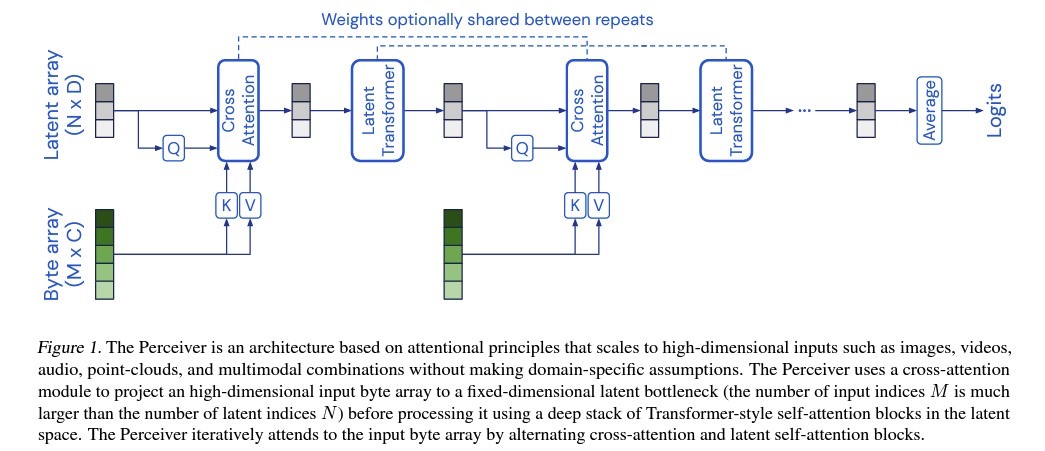Three Important Things
1. Cross-Attention Bottleneck for Efficient Input Processing
One of the key innovations in the Perceiver is the introduction of a cross-attention module. In traditional attention mechanisms, applying the attention operation directly to large-scale inputs, such as images or audio signals, can be computationally expensive. The complexity of self-attention grows quadratically with the size of the input.
The Perceiver tackles this by projecting the input data (such as pixel arrays from images or audio samples) into a much smaller latent array via a cross-attention mechanism. This cross-attention module allows the model to summarize the input into a smaller set of latent vectors, which are then processed by a Transformer. The cross-attention module’s complexity is reduced from quadratic (O(M²)) to linear (O(MN)), where M is the size of the input array, and N is the size of the latent array.
This bottlenecking mechanism allows the Perceiver to handle very large datasets efficiently without sacrificing performance.
2. Deep Transformer Network on Latent Space
After the cross-attention module maps the input into a lower-dimensional latent space, the Perceiver uses a deep Transformer to further process these latent representations. Unlike architectures like Vision Transformers (ViT) that operate directly on the pixel space, the Perceiver performs self-attention only within the latent space.
The latent Transformer has a complexity of O(N²), which is much smaller than the complexity of processing high-dimensional input data directly. By decoupling input size from the depth of the Transformer, the architecture can scale much deeper. For example, in their experiments, the authors built models with up to 48 Transformer layers without becoming computationally prohibitive.

3. Weight Sharing for Parameter Efficiency
To reduce the overall number of parameters and prevent overfitting, the Perceiver architecture uses weight sharing between the different layers of the Transformer blocks. This recurrent-like approach enables the same cross-attention and Transformer layers to be applied repeatedly, unrolling the model in depth.
This technique provides two benefits:
- Reduced Parameter Count: Weight sharing can result in a 10x reduction in parameters compared to non-weight-shared models.
- Improved Generalization: Sharing weights helps the model generalize better on unseen data by reducing overfitting. The architecture essentially operates like an RNN but processes input repeatedly rather than over time.
A Glaring Deficiency
Lack of Explicit Spatial Understanding
Despite its strengths, one of the most glaring deficiencies of the Perceiver architecture is its inherent lack of spatial inductive bias. Traditional CNNs, by design, capture spatial hierarchies using convolutions that operate over local neighborhoods in images. This means CNNs naturally understand how nearby pixels relate to one another, making them effective at capturing spatial relationships and patterns.
In contrast, the Perceiver treats the input as an unordered set of bytes without explicitly leveraging spatial or temporal structure. While position encodings (such as Fourier features) are used to inject positional information, they don’t provide the same level of inductive bias as CNNs. For tasks where spatial locality is critical (e.g., image processing), the Perceiver’s reliance on learned relationships between pixels may result in less effective feature extraction compared to CNN-based models.
Conclusion
The Perceiver architecture marks a significant step forward in handling large-scale and multimodal datasets. Its cross-attention mechanism for input compression and efficient processing in latent space makes it a powerful alternative to traditional models like CNNs and Vision Transformers. However, its generality comes at a cost: the lack of inherent spatial understanding limits its applicability to certain tasks.
Despite this, the Perceiver holds promise for applications requiring general, scalable models capable of handling diverse input types, including audio, images, and video. The model’s flexibility and ability to process large-scale data while keeping computational costs manageable make it an exciting development in the field of machine learning architectures.